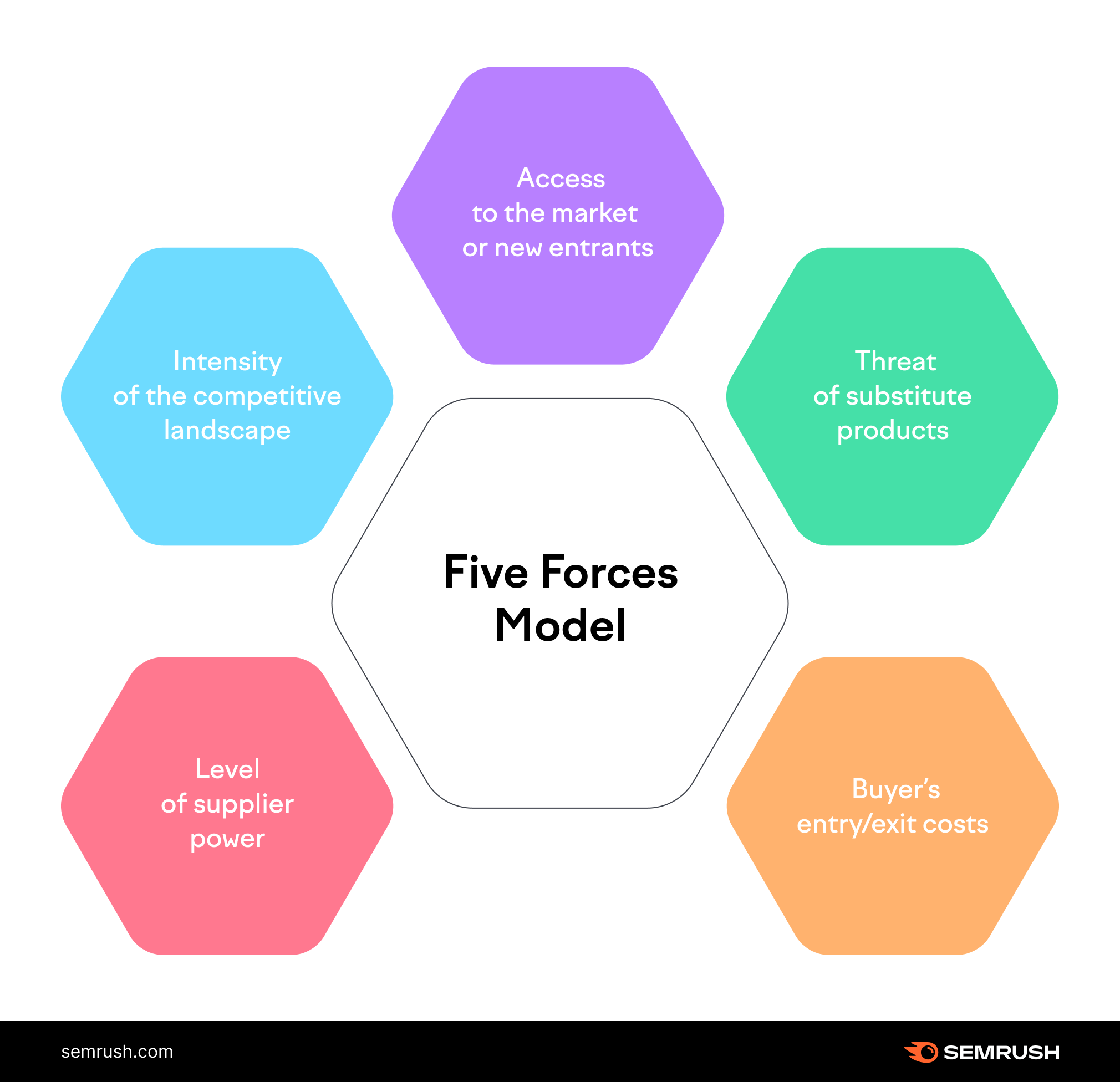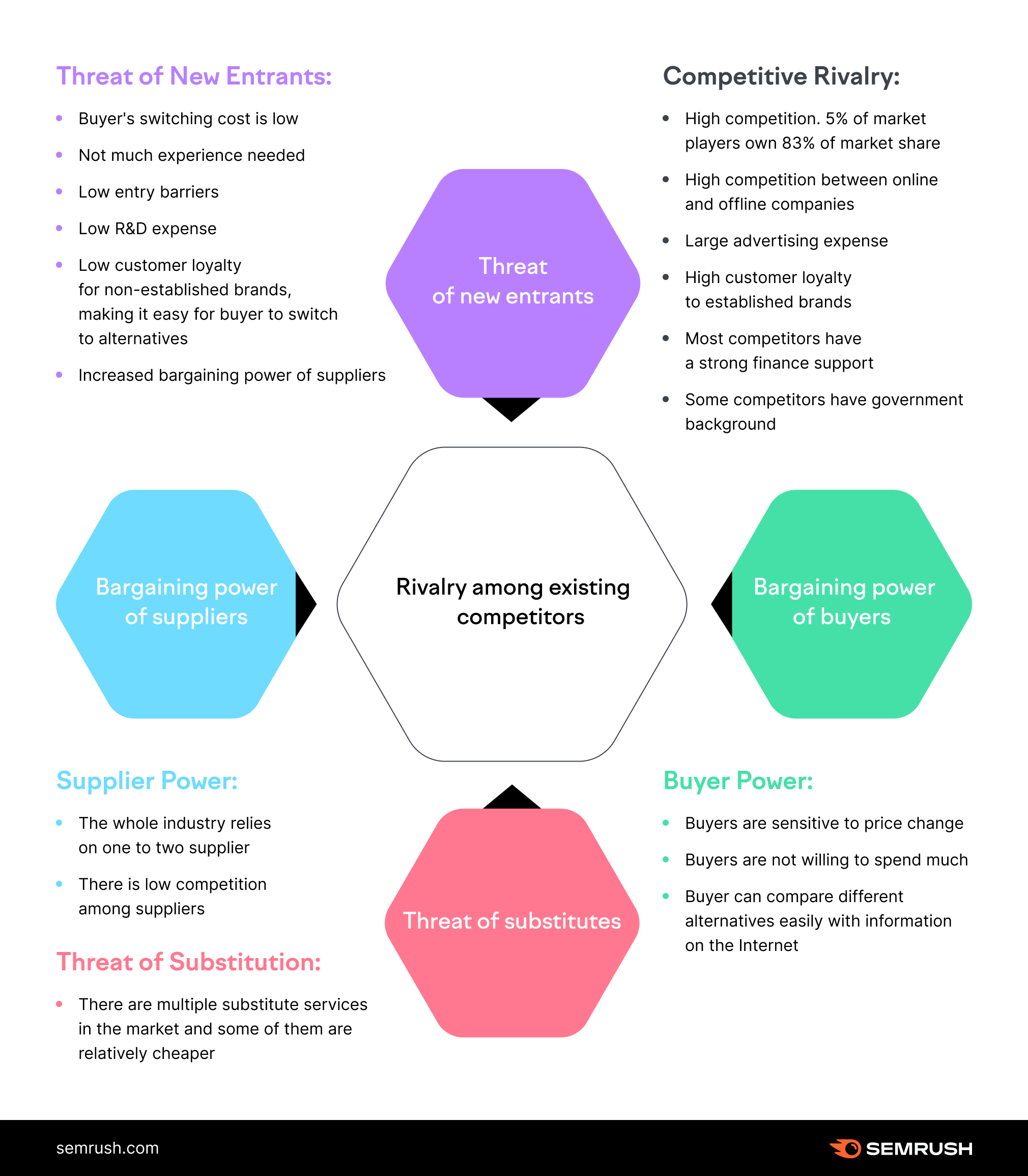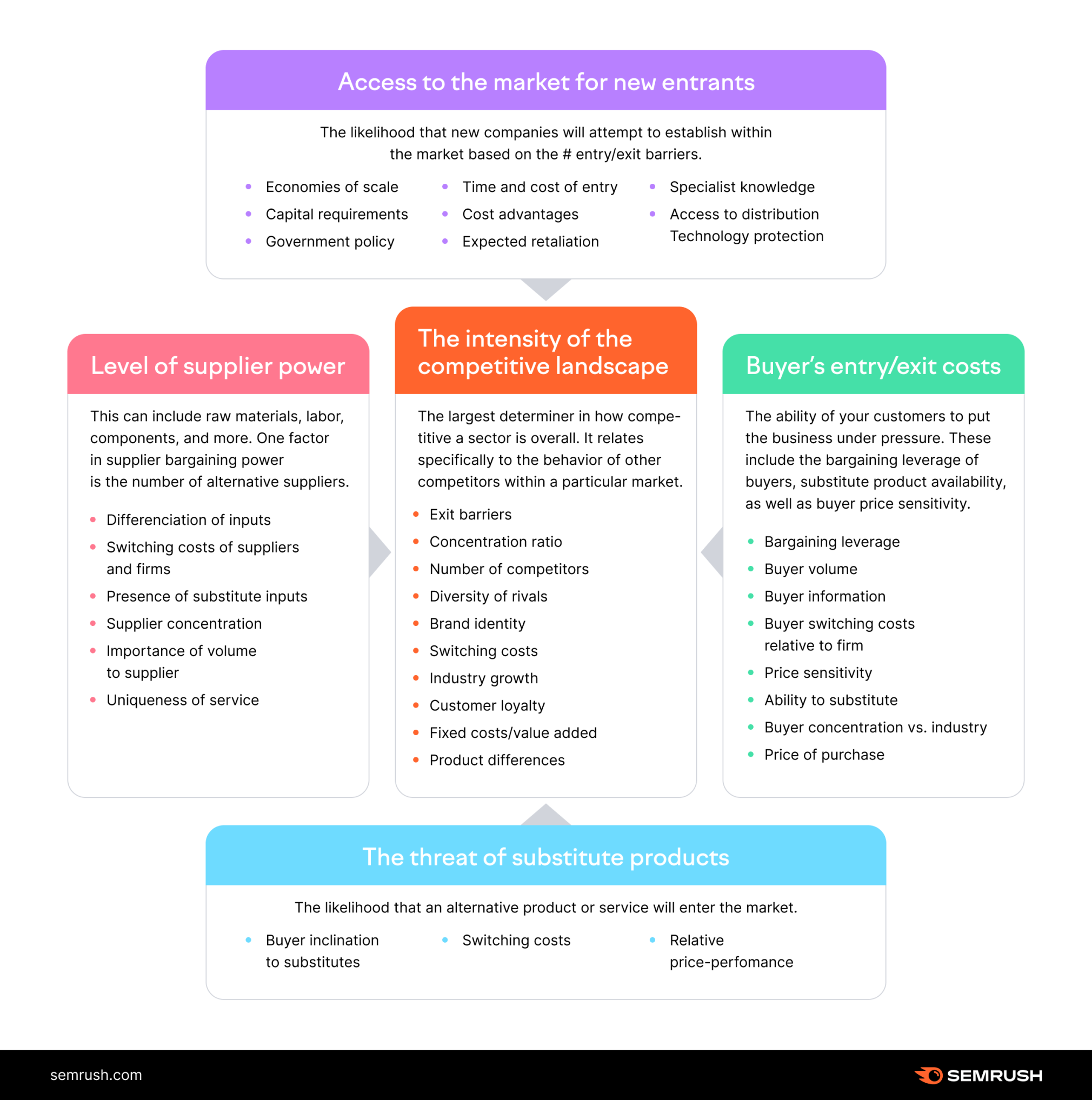According to numerous business experts, appropriate market analysis is a crucial component of a successful business. If you don't adequately assess your competition or sector before starting your business, you run the risk of not properly understanding the best ways to establish your business effectively. One such form of assessment is known as Porter's Five Forces model.
We're going to teach you exactly what Porter's Five Forces are, and how they are best implemented. Then, we'll provide you with a handy template so that you can conduct your own analysis for your business.
What Are Porter's Five Forces?
As the name suggests, Porter's Five Forces are five separate threat factors that can impact business growth. The theory is credited to senior Harvard Business School academic Michael E. Porter.

The Five Forces, or Porter structure, are as follows:
- The intensity of the competitive landscape;
- Level of supplier power;
- Buyer’s entry/exit costs;
- The threat of substitute products;
- Access to the market for new entrants.
The objective of Porter's Five Forces model is to assess the overall competitive landscape of a particular business sector. Each of these five forces corresponds to a key component of market intensity.
When all five of Porter's Five Forces are assessed, a business owner can assess the overall competitiveness of a particular market.
If these forces are particularly strong, they contribute towards an unattractive sector overall. This is because the strength of each negatively affects the overall likelihood of profitability.
The ideal sector is one where “pure competition” exists, allowing all those within it to make respectable profit margins.
Porter’s Five Forces Analysis
The intensity of the competitive landscape
The first thing to look into is how intense the competition is within your niche. The key insights you should gather at this stage are:
- The competition level within the marketplace;
- Key competitors;
- A clear understanding of your competitive strategy.
The Market Summary in the Market Explorer tool provides a great starting place. Taking a data-driven approach, let's get an overview of the competitive landscape for SpaceX.

After examinging the market as a whole, we can zoom into the competitive landscape specifically using the Growth Quadrant.

We’ve only picked the top 10 competitors to show on the graph. You can always go deeper and take a look at more rivals, However, for an in-depth look, it’s always a good idea to narrow down the scope of research.
With space, SpaceX won’t have too many direct competitors — just because the entry bar is very high, with high fixed costs, government regulations, and more. For most industries, however, looking at the range of competition and its intensity is a starting point for solid market analysis.
Then, you have to double-check whether you are sharing a similar audience with your competitors — you may have the same product but be targeting a very different customer base.
Having discovered that NASA and Boeing are SpaceX’s key competitors, we will run the three companies through Traffic Analytics’ Audience Insights report to see if their audiences match.

We can see that Boeing and SpaceX/NASA barely have any audience overlap, which can be explained by the fact that Boeing has other business units (aviation, for instance), while NASA and SpaceX’s higher match comes as no surprise.
Audience analysis on top of a simple competitive analysis shows opportunities and threats that may come from your competitors.
If you are attracting different types of customers, you are less of a threat to each other but may start getting ideas about targeting your rivals’ consumers. This post will walk you through the ways to shape a stronger marketing strategy to attract competitor audiences.
Level of supplier power
Online or offline, businesses are heavily reliant on other businesses in their operations. This factor examines the power a supplier might hold over your business.
Your procurement, security, and other departments will have information about the following factors you should consider when it comes to assessing the threat of overdependence on suppliers:
- The number of suppliers within the market (from your anti-DDoS software to steel mills);
- The range of existing suppliers — the more backup suppliers you manage to secure, the more bargaining power your business will have;
- The costs of switching to other suppliers — from rewiring all the hardware to establishing new supply chains, you should consider all the factors and expenditures.
Buyer’s entry/exit costs
Now, with consumers, they can also have some bargaining power over your business. While this may seem like a customer-centric factor, you should be looking at your competitive landscape once again to determine the costs of the buyer’s entry and exit.
The overall audience size, the number of competitors, their pricing, and quality factors will matter when you are shaping or reshaping your business and marketing strategies.
This post will help you find the right tactics that enable you to:
- Analyze your competitors’ overall online performance;
- Get a glimpse at their online advertising strategies;
- Pinpoint your rivals’ SEO, content and PR strategies;
- Reveal their activity across social media channels.
The threat of substitute products
On top of keeping an eye on competitors and their marketing strategies, you should also be aware of the fact that you might be competing with substitute products too. An indirect competitor might be impacting your profitability as your customers are switching to a different product or service.
Normally, a substitute product constitutes a threat if:
- It comes at a lower price but with a similar function or quality.
- It offers a similar price but is of higher quality or is more functional.
Access to the market for new entrants
This factor considers how easy or difficult it is to enter the market for upcoming brands. While you may be all set with your market analysis, this factor requires ongoing market monitoring.
While SpaceX’s position is fairly stable, Asian competitors like Interstellar Technologies may pose a threat in years to come.
However, if you’re not in Aerospace or another niche that is difficult to enter, you should consider the market entry barriers and establish the frequency of your market monitoring accordingly — the lower the entry bar, the higher the monitoring frequency.
Here is a live example of Porter’s Five Forces analysis:

Porter's Five Forces Template
A template for Porter's Five Forces provides you with the layout of the model and how each force impacts the others.
Remember, the objective of Porter's Five Forces model is to review the competitiveness of a market. If you're already operational, this can give you a significant advantage over your competition.
Used properly, the model can be adapted to create comprehensive competitive strategies. These can then help you carve out an even more significant portion of the overall market for your business.
Take a look at our comprehensive Porter's Five Forces template here.

[ Download the Porter's Five Forces Template ]
Where Can I Find Out More About Marketing Strategies?
Porter's competitive model is one of the most well-recognized marketing strategies available today. But relying solely on Porter's Five Forces means you won't be taking advantage of other significant strategies.
The best way to get ahead in your sector is by contributing as much as possible to competitive assessment and business growth. Luckily, that's where Semrush can help.
Semrush provides over 40 digital marketing tools to help you thrive in your sector. This includes tools for Competitor Analysis and Competitor SEO Analysis, among many more.
